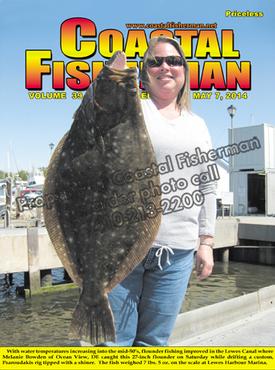


Article by Capt. Mark Sampson
 Although sharks are available to Delmarva anglers all season long, May and June are the two months when they are heavily pursued by local anglers. In most cases “shark fishing” involves “shark chumming” where the goal is to stream out a long chumline (or scent-line) that traveling sharks will intercept and choose to follow to its source, where they encounter the anglers baited hooks.
Although sharks are available to Delmarva anglers all season long, May and June are the two months when they are heavily pursued by local anglers. In most cases “shark fishing” involves “shark chumming” where the goal is to stream out a long chumline (or scent-line) that traveling sharks will intercept and choose to follow to its source, where they encounter the anglers baited hooks.
If the boat is anchored, the direction and distance of the scent-trail is determined primarily by the current. The stronger the flow, the farther the scent will travel during a given period. If the boat is drifting, the actual direction of the chum flow is more difficult to figure out because it’s a result of the direction of the current as well as the course the boat is drifting, which is usually determined by the direction of the wind. Even though the boat will travel far and fast when the wind and current are moving in the same direction, the scent-trail might not extend as a far from the boat as when wind and current are going in opposite directions.
Therefore, what to some anglers might seem like a “good drift” could actually just be them drifting with their chum all day rather than away from it.
It’s safe to say, however, that in most cases when a boat shuts down and starts leaking chum, the scent will be carried away in such a manner that anglers will have a shot at tempting in some sharks.
Since most chum is made from fish that have been ground-up to the consistency of burger, after leaving the chum bucket, the bits of chum drift down and away from the boat and, unless they get eaten by some small fish along the way, eventually hit the seafloor. As the bits of chum sink, they release their scent, which is carried along by the current. Because the bits of chum are always sinking downward, the scent fans out from the boat and can eventually cover the entire water column from the surface to the bottom.
I provide this description because anglers commonly make the mistake of thinking that the scent trail leaves their boat in a line directly opposite from the way they’re drifting and that it stays in the upper water column close to the surface. Knowing what’s really going on with the chum should help anglers plan out their strategies and choose the right place to anchor their boat or start their drift.
Knowing that their scent trails cover not just the surface, but the entire water column, should help anglers keep their cool when another skipper doesn’t follow proper fishing etiquette and runs his vessel across their chumline, because, contrary to the prevailing thoughts of many, running across someone’s chumline does not “break the line” and minimize its effectiveness. Detouring around someone else’s chumline shows common courtesy to other fishermen, but it’s not the end of the world if someone doesn’t do it for you.
What actually can be a problem for sharkers is when another boat sets up a chumline too close to another boat. Think of the chumline flowing from the boat as a long fence. Sharks traveling from the left or right will swim into the fence, become interested in the scent, then turn and follow the fence to the boat. So what happens if another boat sets up their own chumline on one side or the other from you? With now “two” parallel fences, any shark traveling in from the side of the other boat is going to encounter that chumline first and very possibly go to that boat instead of yours. By setting up close to you, the other boat may have reduced the potential number of sharks in your chumline by 50%. Needless to say, that could be the difference between having a “great” day or a “slow” day of fishing.
So how close is too close? The answer to that question probably depends a lot on the location and the prevailing winds and currents. But as a rule of thumb, I like to be at least two-miles from any other shark fishermen to feel somewhat confident that we’re not competing for the affection of the same sharks. But whenever possible, I like to fish where I have a shot of not seeing another boat anywhere on the horizon. Of course, places like that can be tough to find on a nice day in prime season.
Even if they are able to stay more than two miles apart, anglers who have to set up within sight of another boat should avoid choosing a starting location that is up or down current from the other boat, otherwise the two scent-trails might eventually merge into one long stream and, again, have them vying for the same sharks.
With the offshore shark season coming up fast, it won’t be long before anglers are heading out of the inlet with hopes of hooking up with some of the biggest and baddest fish in the ocean. Armed with a good understanding of what happens from the time the chum leaves their boat until a shark picks up on it’s scent, anglers should be able to not only choose a proper and productive place to start fishing, but also to keep their blood pressure at a reasonable level, even if a boatload of “yahoos” (who didn’t read this article) pass through their chumline.
Captain Mark Sampson is an outdoor writer and captain of the charter boat “Fish Finder”, docked at the Ocean City Fishing Center.